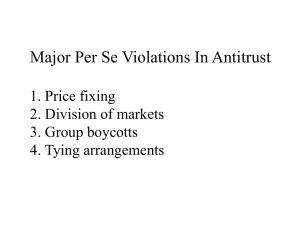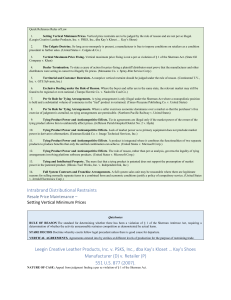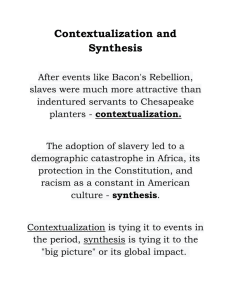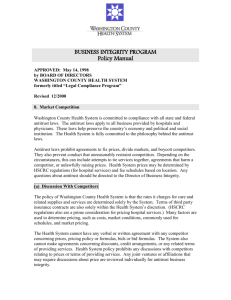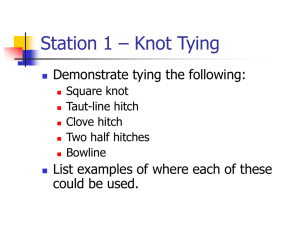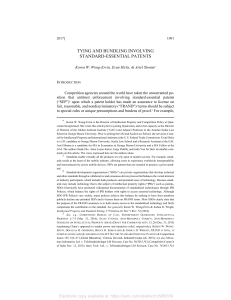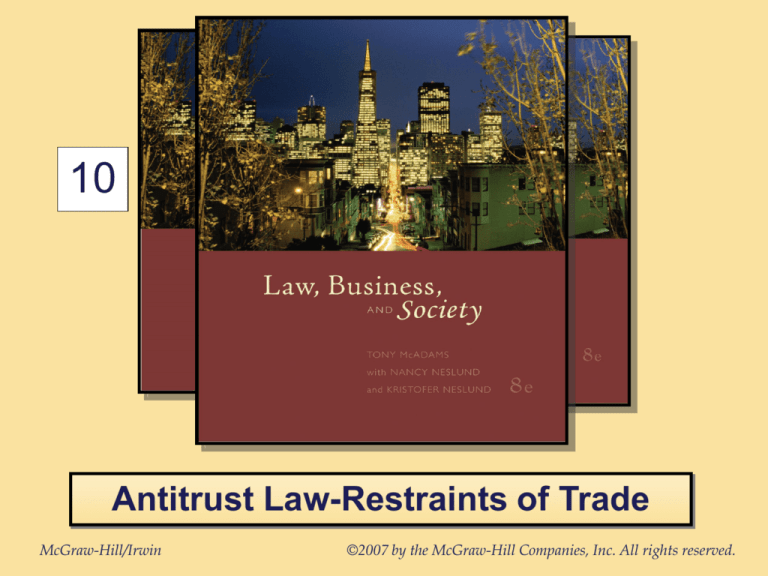
10
Antitrust Law-Restraints of Trade
McGraw-Hill/Irwin
©2007 by the McGraw-Hill Companies, Inc. All rights reserved.
Chapter
10
Antitrust Law-Restraints
of Trade
Key Points
• Identify the goals of antitrust law
• Understand horizontal restraints
• Price-fixing
• Refusal to deal
• Understand vertical restraints
• Resale price maintenance
• Tying arrangements
• Exclusive dealing and requirements contracts
• Price discrimination
Antitrust Goals
1. The preservation of competition
2. The preservation of democracy so that a few
large businesses can’t corner economic,
political or social power
3. The preservation of small business, that is,
the preservation of the American dream
4. A tool for reshaping America to meet the
needs of all of the people, rather than those of
big business
Antitrust Statutes
Sherman Antitrust Act (1890):
• Section 1 forbids restraints of trade
• Section 2 forbids monopolization, attempts to
monopolize and conspiracies to monopolize
Clayton Act (1914):
• Forbids price discrimination, exclusive dealing, tying
arrangements, requirements contracts, mergers
restraining commerce or tending to create a monopoly,
and interlocking directorates
Federal Trade Commission Act (FTC):
• Created the FTC to eliminate anticompetitive practices
• Section 5 declares unlawful “unfair methods of
competition” and “unfair or deceptive acts or practices in or
affecting commerce
Horizontal Restraints
Definition: When competitors collude, conspire or agree
among themselves they are engaging in horizontal restraints
of trade; instead of competing to drive prices down and
quality up, they may be fixing prices, restricting output and
dividing territories
Standard Oil (S. Ct. 1911): Only unreasonable restraints of
trade are prohibited
The Rule of Reason: Balance the pro- and anti-competitive
effects of the situation in question
Per se violations: Some antitrust violations, such as horizontal
price fixing, are perceived to be so injurious to competition
that their mere existence constitutes unlawful conduct
Horizontal Price-Fixing
Standard: Competitors may not lawfully agree on prices
Four Methods of proof:
• Agreement with direct evidence (e.g., writings or testimony)
• Agreement without direct evidence (i.e., proven by circumstantial evidence)
• Agreement based on a tacit understanding (e.g., the parties employ tactics
that act as surrogates for direct assurances and thus “tell” each other that
they are, in fact, in agreement)
• Agreement based on mutual observation (e.g., competitors anticipate each
other’s future conduct and act accordingly without any direct collision but with
results akin to those that would have resulted from a direct agreement)
Contrast: Parallel conduct (i.e., independent but parallel business behavior)
which is legal; business judgment had led each to independently follow parallel
paths.
Examples
•
Insurance bid rigging by insurance
brokerage firm Marsh & McLennan
•
Conspiracy to fix corn syrup prices by
Archer Daniels Midland and others
•
Global price-fixing by international vitamin
manufacturers
Information Sharing
• Information sharing among competitors can be legal or
illegal, based on whether it enhances efficiencies or
restrains trade
• Primary analytical factors:
• Evidence of conscious parallelism
• “Plus factors,” such as motive to conspire and a
high level of interfirm communication
Example: Fears v. Wilhelmina Model Agency (S.D.N.Y.
2004)
Refusal to Deal (a/k/a Group Boycott)
• A horizontal group boycott involving a group with market
power and no purpose other than restricting output or
raising prices will probably be treated as a per se
violation
• Other boycotts that have some lawful primary
purpose are more likely to be subject to Rule of
Reason analysis
• Noncommercial political boycotts (likely to be legal if
impact 1st Amendment rights)
Example: U.S. v. Visa International and MasterCard
International (2d Cir 2003)
Vertical Restraints
Types:
• Resale price maintenance
• Tying arrangement
• Exclusive dealing and requirements
contracts
• Price discrimination
Analysis: Rule of Reason
Example: Pricing of CDs in the ’90s
Resale Price Maintenance and
Vertical Non-price Restraints
• Legitimate goals of resale price maintenance:
• By establishing a minimum prices, the product’s reputation for quality may
be enhanced
• To prevent discount stores from undercutting regular retail outlets
• To prevent free riders (e.g., on national advertising campaigns)
• Colgate Doctrine: Sellers may lawfully engage in resale price maintenance if
they do nothing more than specify prices at which their products are to be sold
and unilaterally refuse to deal with anyone who does not adhere to those prices
• Rule of Reason analysis applies
Example: Business Electronics v. Sharp Electronics (S. Ct. 1988)
Tying Arrangements
Definition: Customer allowed to lease or buy a desired
product (the tying product) only if she or he also leases
or buys another product (the tied product)
Concerns:
• Party who already enjoys market power over tying
product is able to extend that power into tied product market
• Competitors in tied product market are foreclosed from
equal access to that market
Examples:
• Visa/MasterCard requiring vendors to accept their debit,
as well as credit, cards
• Queen City Pizza v. Domino’s Pizza (3d Cir. 1997)
Tying Analysis
Proof of the following conditions constitutes a per se
tying violation:
1. Existence of separate products
2. Requirement that purchase of one product
(tying product) is conditioned on purchase of
another (tied product)
3. Market power in tying product
4. Substantial commerce in tied product is
affected or, for some courts, a substantial
anticompetitive effect in tied product market
Exclusive Dealing and
Requirements Contracts
Exclusive dealing contract: Agreement in which buyer
commits itself to deal only with specific seller, thus
cutting competing sellers out of share of market
Requirements contract: Agreement in which seller
agrees to supply all of buyer’s needs, or a buyer
agrees to purchase all of seller’s output, or both
Effects:
• May reduce or eliminate intrabrand competition
• May enhance interbrand competition
Analysis: Rule of Reason
Price Discrimination
Price discrimination (illegal): Selling substantially
identical goods (not services) at reasonably
contemporaneous times to different purchasers at
different prices, where effect may be to substantially
lessen competition or tend to create a monopoly
Price discrimination (legal):
• Price differentials attributable to cost savings
• Price differentials attributable to good faith effort to
meet equally low prices of competitor
• Price change in response to changing market
Example: Intimate Bookshop v. Barnes & Noble (S.D.N.Y.
2005)
Predatory Pricing
Definition: Lowering prices to drive out competition
with expectation that it can recover any
losses later by charging monopoly prices
Proof:
• Prices set below average variable cost
• Ability to recoup in future through exercise of
market power
Example: American Airlines in Dallas-Fort Worth

